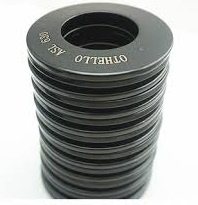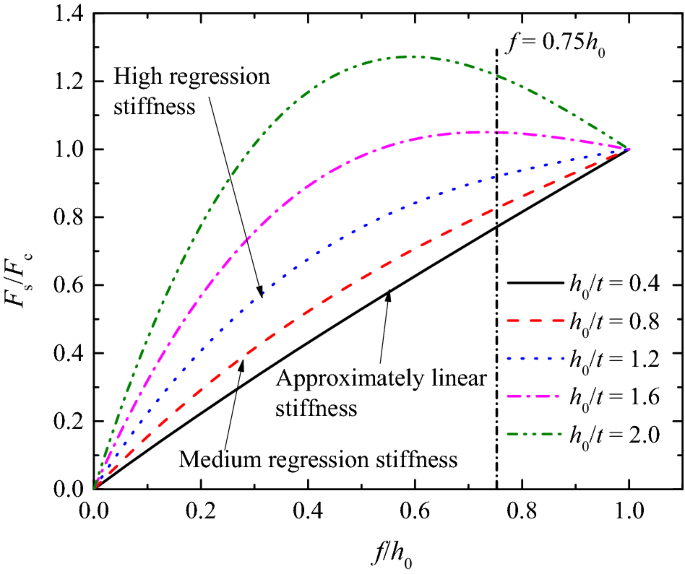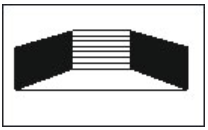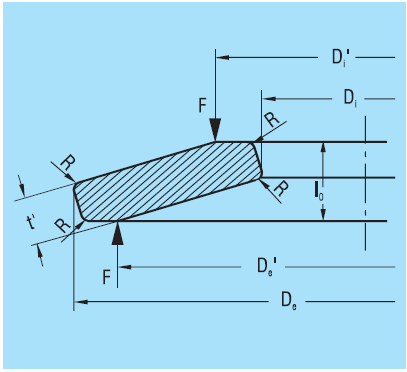DIN-EN-16983 (DIN 2093) – Quality & Dimensions
The German DIN standard, (Deutches Institut fur Normung) has integrated at the European and International levels. Their standards committees aligned German interests with those of CEN and ISO. Thus the DIN 2093 has been incorporated into a European standard. There has been no real or substantive change. .

For information on ordering disc springs and the information we require, please go to this page.
For more information on how we go about our design and load characteristic performance verification, please view our approach to design calculations.
Follow these links for lists of all sizes available in DIN 2093 Group 1 and 2 sizes and all the Group 3 disc springs we offer as standard.
Conical Disc Spring - Groups and Classifications
Disc Springs are conically formed angular discs, which are loaded in the axial direction. They can be used as a single disc or arranged in stacks. A Disc Spring stack can consist of disc springs arranged in either Series or Parallel sets, and we cover this briefly below. The DIN 2093 standard divides or classifies disc springs into 3 groups as given in the table:
Series
Within each Group there are three Series — A, B, and C. These series are differentiated by material thicknesses and
the corresponding Load Characteristic Curves or force/deflection curves they will generate, as illustrated in the accompanying diagram.
 DIN EN 16983 (formerly DIN 2093) categorizes the three series by the following approximate ratios:
DIN EN 16983 (formerly DIN 2093) categorizes the three series by the following approximate ratios:
- Series A where De/t ≈ 18 and ho/t ≈ 0.4
- Series B where De/t ≈ 28 and ho/t ≈ 0.75
- Series C where De/t ≈ 48 and ho/t ≈ 1.3
Group 3
Contact Flats
In group 3, we call the contact flat, an annulus, the DIN 2092 refers to it as a ground surface end, and the SAE HS1582 Spring Design Manual as a Contact Bearing Flat. some call it the working surface. These have a purpose
- to improve the definition of the point where the load is applied
- and in stack configurations, to reduce the friction on the guide rod.
Reduced Thickness - t'
Using a contact flat shortens the the moment arm. If you introduce a contact flat, the disc spring requires a greater load for the same deflection. For very practical reasons of interchangeability, which means maintaining the free height of a spring, and matching loads as closely as possible, the thickness of the disc spring must be reduced. This is denoted by t' (t dashed).
Disc Spring configurations
Disc springs can be stacked in series, parallel or a combination of the two. This allows for great flexibility in achieving both the working load as well as deflection parameters required for a particular engineered application. Note: the accepted nomenclature depicts values relating to the stack with a capital letter and those to a single disc spring in lower case,
When stacked in Series,
where i is the number of disc springs in series:
- the Total applied Load of the Stack = applied load of a single disc. Fstack = fsingle disc
- the Total Stack Deflection = the Deflection of a single disc multiplied by the number of discs in the stack which translates to: S= i.s which if read aloud is Sstack = i · ssingle .
- similarly, the Unloaded Stack Height = the height of a single disc multiplied by the number of packets in the stack L0 = i. l0 and finally,
When stacked in parallel
(think of how you would pack spoons neatly in a cutlery draw, each fitting into the next so as to take up less space).
For a single packet of n disc springs in parallel:
- the Total Load of the stack = Load of a single disc multiplied by number of discs n in parallel.
- the Total Deflection of the entire stack = the Deflection of a single disc spring, ie. S = s ,and finally
- the Unloaded Stack Height = height of a single unloaded disc spring plus the total number of discs in parallel n minus 1 multiplied by the thickness t (or t') of a single disc spring
ie L0 = l0 + (n-1).t or t
'
Progressive, Linear & Degressive - Load Curve Response
One might expect that the engineering requirement for a spring stack be that the spring load increases linearly as the load/compression increases, i.e. the rate of the force characteristic remains constant. This need not be so and instead different charactieristics can be achieved. We can design the stack so that beyond a certain amount of deflection the force required to further compress the stack increases (progressive), or plateaus off (de-gressive). These can be achieved through the application of different stack configurations using the principles introduced above.
The key points on disc springs:
- Typically are used with hardened bolts ranging from grade 8.8, 10.9 and 12.9 (US-Grade 5, 8 & A325)
- They are made from a wide variety of special spring steels depending on the operating environment conditions
- They are through hardened to between Vickers HV 420 and 510 (Rockwell C, HRC 43-52)
- Electroplating is discouraged, as this may result in the disc springs becoming brittle and failing!
- Ambient temperature
- Presence of corrosive substances
- Strength of electromagnetic fields
Technical Dimensions - DIN-EN-16983 (DIN 2093)
Although we are principally known for specialising in the larger Group 3 reduced thickness disc springs with contact surfaces (thicknesses of 6mm and greater), we do cater for the smaller sizes, such as these listed below.` Click Here to download information on all the Group 3 disc springs we offer as standard.


